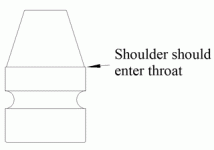An undersize bullet is a serious problem. When a bullet is undersize, it will lean to one side of the bore so the rifling marks are deeper on one side of the bullet than they are on the other side. This will cause keyholing.
Another way the same thing happens is when the rifling in the barrel is not made an even depth all around. I have seen this twice. Once in a Dan Wesson revolver barrel and once in a S&W m.41 barrel. In both cases the bullets keyholed. So carefully inspect your bore to be sure the rifling is the same height on every land.
Additionally, with lead bullets that are smaller than the groove diameter of the bore, gas escapes between the bullet and the bore and that strips lead off the bullet, unbalancing it, and building the lead up in the bore. The build-up subsequently deforms other bullets coming through. This can cause keyholing, too.
But it is strange to me that an RCBS mold would be undersized that much. You might be casting with an unusual alloy that shrinks too much and comes out undersized. It might also be your measuring method. It is easy to make some calipers read too small if they flex at all when the jaws close on the object you are measuring.
I suggest you slug the barrel. This means you must get it completely clean and then run a lightly oiled patch through it and use a brass punch to push a plain lead (no alloy) slug into the bore and then through the bore. Plain lead has almost no elasticity, so it will be the diameter of the bore when it comes out. Measure the groove pattern (wide place) on the slug when it comes out. Ideally, you want a cast lead bullet that measures 0.001" to 0.002" bigger than the slug, which should be 0.355", but will be smaller if your measuring method is slightly off. The main point is that it is the difference between the two measurements that matters, not the absolute numbers.
Google Translate Version:
Una viñeta de menor tamaño es un problema grave. Cuando una bala es de menor tamaño, se inclinará hacia un lado del agujero para que las marcas de estrías sean más profundas en un lado de la bala que en el otro lado. Esto causará envejecimiento.
Otra forma en que sucede lo mismo es cuando el rifling en el cañón no tiene una profundidad uniforme en todas partes. He visto esto dos veces. Una vez en un cañón revólver Dan Wesson y una vez en un cañón S&W m.41. En ambos casos las balas con cerradura. Por lo tanto, inspeccione cuidadosamente su orificio para asegurarse de que el estriado tenga la misma altura en cada terreno.
Además, con las balas de plomo que son más pequeñas que el diámetro de la ranura del orificio, el gas escapa entre la bala y el orificio y esas tiras conducen la bala, desequilibrándola y construyendo el plomo en el orificio. La acumulación posteriormente deforma otras balas que pasan. Esto también puede causar envejecimiento.
Pero es extraño para mí que un molde RCBS sea tan pequeño. Es posible que esté fundiendo con una aleación inusual que se encoge demasiado y sale demasiado pequeña. También podría ser tu método de medición. Es fácil hacer que algunos calibradores lean demasiado pequeños si se flexionan cuando las mandíbulas se cierran sobre el objeto que está midiendo.
Te sugiero que golpees el barril. Esto significa que debe dejarlo completamente limpio y luego pasar un parche ligeramente engrasado a través de él y usar un punzón de latón para empujar una bala de plomo (sin aleación) en el orificio y luego a través del orificio. El plomo liso casi no tiene elasticidad, por lo que será el diámetro del agujero cuando salga. Mida el patrón de ranura (lugar ancho) en la bala cuando salga. Idealmente, desea una bala de plomo fundido que mida 0.001" a 0.002" más grande que la bala, que debería ser 0.355", pero será más pequeña si su método de medición está ligeramente apagado. El punto principal es que es la diferencia entre los dos medidas que importan, no los números absolutos.

